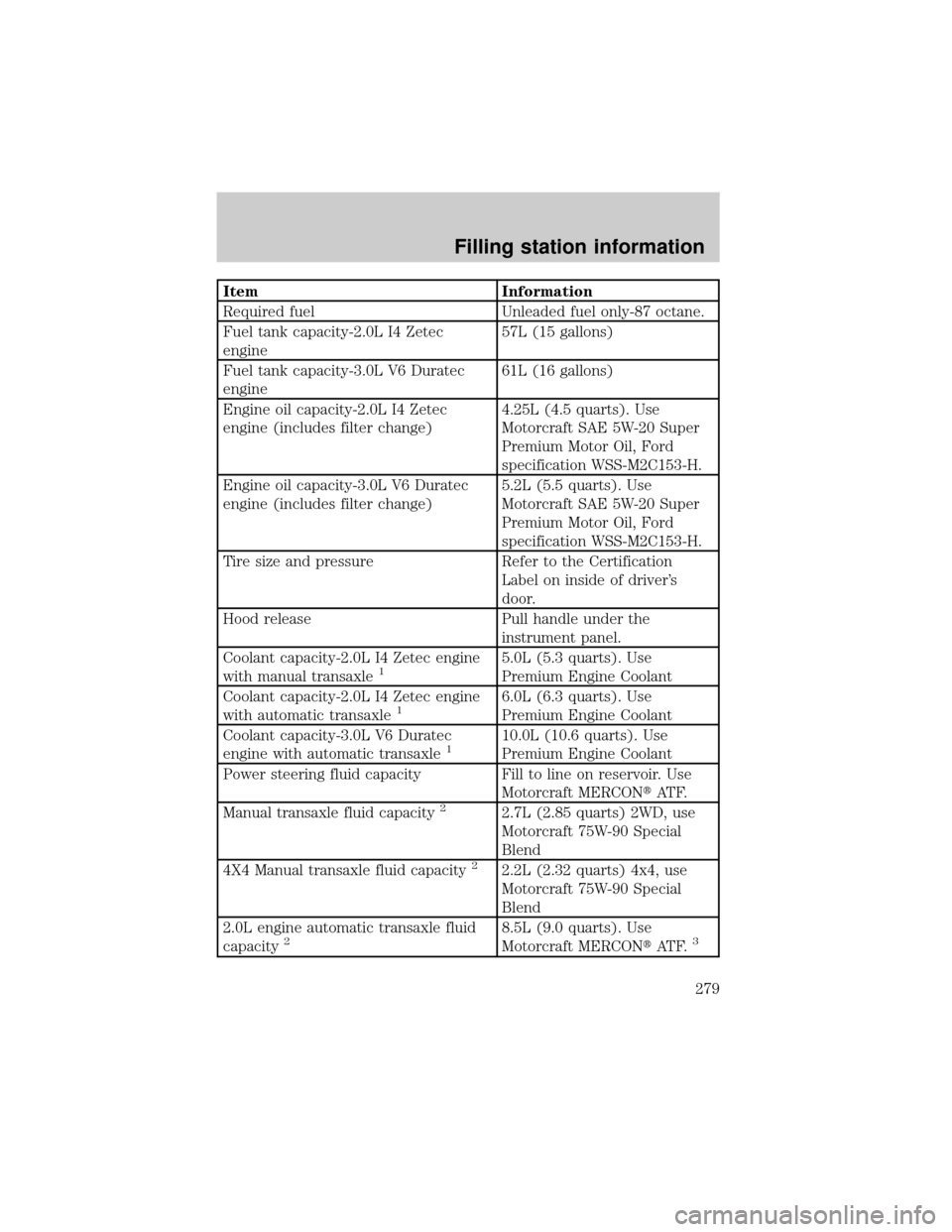2001 FORD ESCAPE tire pressure
[x] Cancel search: tire pressurePage 144 of 280

Always set the parking brake fully and make sure that the
gearshift is securely latched in P (Park) (automatic
transmission) or in 1 (First Gear) (manual transmission).
The parking brake is not recommended to stop a moving vehicle.
However, if the normal brakes fail, the parking brake can be used to stop
your vehicle in an emergency. Since the parking brake applies only the
rear brakes, the vehicle's stopping distance will increase greatly and the
handling of your vehicle will be adversely affected.
To release the parking brake, the
brake handle may need to be pulled
up slightly to release pressure
before pushing in the button.
Push the button on the end of the
parking brake handle and push the
handle down as far as possible.
Driving with the parking brake
applied will cause the brakes to
wear out quickly and reduce fuel
economy.
STEERING
Your vehicle is equipped with power steering. Power steering uses energy
from the engine to help steer the vehicle.
To prevent damage to the power steering pump:
²Never hold the steering wheel to the extreme right or the extreme left
for more than a few seconds when the engine is running.
²Do not operate the vehicle with a low power steering pump fluid level
(below the MIN mark on the reservoir).
If the power steering system breaks down (or if the engine is turned
off), you can steer the vehicle manually, but it takes more effort.
If the steering wanders or pulls, the condition could be caused by any of
the following:
²underinflated tire(s) on any wheel(s)
²uneven vehicle loading
²high crown in center of road
Driving
144
Page 153 of 280

If your vehicle gets stuck
If the vehicle is stuck in mud or snow select the 4x4 ON operating mode.
It may be rocked out by shifting from forward and reverse gears,
stopping between shifts, in a steady pattern. Press lightly on the
accelerator in each gear.
Do not rock the vehicle if the engine is not at normal operating
temperature or damage to the transaxle may occur.
Do not rock the vehicle for more than a few minutes or damage
to the transaxle and tires may occur or the engine may overheat.
Do not spin the wheels at over 56 km/h (35 mph). The tires may
fail and injure a passenger or bystander.
Sand
When driving over sand, try to keep all four wheels on the most solid
area of the trail. Do not reduce the tire pressures but shift to a lower
gear and drive steadily through the terrain. Apply the accelerator slowly
and avoid spinning the wheels.
Mud and water
If you must drive through high water, drive slowly. Traction or brake
capability may be limited.
When driving through water, determine the depth; avoid water higher
than the bottom of the hubs (if possible) and proceed slowly. If the
ignition system gets wet, the vehicle may stall.
Once through water, always try the brakes. Wet brakes do not stop the
vehicle as effectively as dry brakes. Drying can be improved by moving
your vehicle slowly while applying light pressure on the brake pedal.
After driving through mud, clean off residue stuck to rotating driveshafts,
halfshafts and tires. Excess mud stuck on tires and rotating driveshafts
causes an imbalance that could damage drive components.
If the transaxle Power Take Off unit or rear axle are submerged in water,
their fluids should be checked and changed, if necessary.
Driving
153
Page 157 of 280

Your vehicle has the capability to haul more cargo and people than most
passenger cars. Depending upon the type and placement of the load,
hauling cargo and people may raise the center of gravity of the vehicle.
Calculating the load your vehicle can carry/tow
1. Use the appropriate maximum gross combined weight rating (GCWR)
chart to find the maximum GCWR for your type engine and rear axle
ratio.
2. Weigh your vehicle as you customarily operate the vehicle without
cargo. To obtain correct weights, try taking your vehicle to a shipping
company or an inspection station for trucks.
3. Subtract your loaded vehicle weight from the maximum GCWR on the
following charts. This is the maximum trailer weight your vehicle can tow
and must fall below the maximum shown under maximum trailer weight
on the chart.
DRIVING THROUGH WATER
Do not drive quickly through standing water, especially if the depth is
unknown. Traction or brake capability may be limited and if the ignition
system gets wet, your engine may stall. Water may also enter your
engine's air intake and severely damage your engine.
If driving through deep or standing water is unavoidable, proceed very
slowly. Never drive through water that is higher than the bottom of the
hubs.
Once through the water, always try the brakes. Wet brakes do not stop
the vehicle as effectively as dry brakes. Drying can be improved by
moving your vehicle slowly while applying light pressure on the brake
pedal.
Driving through deep water where the transaxle is submerged
may allow water into the transaxle and cause internal damage.
TRAILER TOWING
Trailer towing with your vehicle may require the use of a trailer tow
option package.
Trailer towing puts additional loads on your vehicle's engine, transaxle,
axle, brakes, tires, and suspension. For your safety and to maximize
vehicle performance, be sure to use the proper equipment while towing.
Driving
157
Page 221 of 280

which all passenger car tires must meet under the Federal Motor Vehicle
Safety Standard No. 109. Grades B and A represent higher levels of
performance on the laboratory test wheel than the minimum required by
law.
The temperature grade for this tire is established for a tire that
is properly inflated and not overloaded. Excessive speed,
underinflation, or excessive loading, either separately or in
combination, can cause heat buildup and possible tire failure.
SERVICING YOUR TIRES
Checking the tire pressure
²Use an accurate tire pressure gauge.
²Check the tire pressure when tires are cold, after the vehicle has been
parked for at least one hour or has been driven less than 5 km (3
miles).
²Adjust tire pressure to recommended specifications found on the
Certification Label. Tire pressure information can also be found on the
Tire Information label located on the inside of the fuel filler door.
Improperly inflated tires can affect vehicle handling and can fail
suddenly, possibly resulting in loss of vehicle control.
Tire rotation
Because your vehicle's tires perform different jobs, they often wear
differently. To make sure your tires wear evenly and last longer, rotate
them as indicated in the scheduled maintenance guide. If you notice that
the tires wear unevenly, have them checked.
Maintenance and care
221
Page 275 of 280

warning light and
chime ...........................12, 15, 113
Safety seats for children ..........128
Seat belts (see Safety
restraints) ..................................107
Seats ............................................98
child safety seats ....................128
cleaning ...................................245
SecuriLock passive anti-theft
system ....................................93±94
Servicing your vehicle ..............196
Snowplowing .................................5
Spark plugs,
specifications .....................247, 252
Special notice ................................4
ambulance conversions ..............5
utility-type vehicles ....................4
Specification chart,
lubricants ...........................250, 252
Speed control ..............................73
Speedometer ...............................17
Starting your vehicle ........137, 139
jump starting ..........................188
Steering wheel
controls ......................................73
T
Tachometer .................................17
Temperature control (see
Climate control) ..........................21
Tires ...........................183, 219±221
changing ..........................183±184
checking the pressure ............221
replacing ..................................223rotating ....................................221
snow tires and chains ............223
tire grades ...............................220
treadwear ................................220
Towing .......................................157
recreational towing .................161
trailer towing ..........................157
wrecker ....................................194
Transaxle
automatic operation ...............146
fluid, checking and adding
(manual) .................................216
Transmission
fluid, checking and adding
(automatic) .............................214
fluid, refill capacities ..............247
lubricant specifications ..250, 252
Turn signal ............................12, 71
V
Vehicle dimensions ...................252
Vehicle Identification Number
(VIN) ..........................................254
Vehicle loading ..........................155
Ventilating your vehicle ...........141
W
Warning chimes ...........................15
Warning lights (see Lights) .......10
Washer fluid ..............................206
Water, Driving through .............157
Windows
power .........................................82
rear wiper/washer .....................77
Index
275
Page 279 of 280

Item Information
Required fuel Unleaded fuel only-87 octane.
Fuel tank capacity-2.0L I4 Zetec
engine57L (15 gallons)
Fuel tank capacity-3.0L V6 Duratec
engine61L (16 gallons)
Engine oil capacity-2.0L I4 Zetec
engine (includes filter change)4.25L (4.5 quarts). Use
Motorcraft SAE 5W-20 Super
Premium Motor Oil, Ford
specification WSS-M2C153-H.
Engine oil capacity-3.0L V6 Duratec
engine (includes filter change)5.2L (5.5 quarts). Use
Motorcraft SAE 5W-20 Super
Premium Motor Oil, Ford
specification WSS-M2C153-H.
Tire size and pressure Refer to the Certification
Label on inside of driver's
door.
Hood release Pull handle under the
instrument panel.
Coolant capacity-2.0L I4 Zetec engine
with manual transaxle
15.0L (5.3 quarts). Use
Premium Engine Coolant
Coolant capacity-2.0L I4 Zetec engine
with automatic transaxle
16.0L (6.3 quarts). Use
Premium Engine Coolant
Coolant capacity-3.0L V6 Duratec
engine with automatic transaxle
110.0L (10.6 quarts). Use
Premium Engine Coolant
Power steering fluid capacity Fill to line on reservoir. Use
Motorcraft MERCONtAT F.
Manual transaxle fluid capacity
22.7L (2.85 quarts) 2WD, use
Motorcraft 75W-90 Special
Blend
4X4 Manual transaxle fluid capacity
22.2L (2.32 quarts) 4x4, use
Motorcraft 75W-90 Special
Blend
2.0L engine automatic transaxle fluid
capacity
28.5L (9.0 quarts). Use
Motorcraft MERCONtAT F.3
Filling station information
279